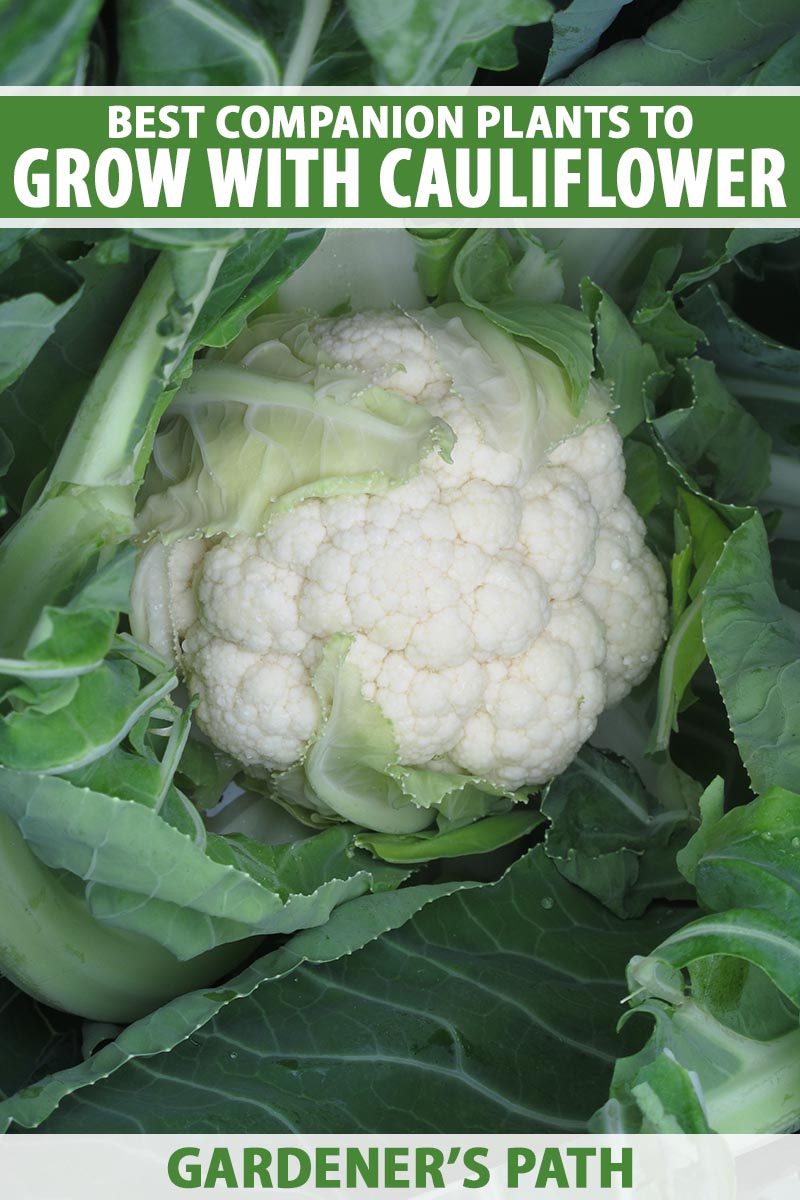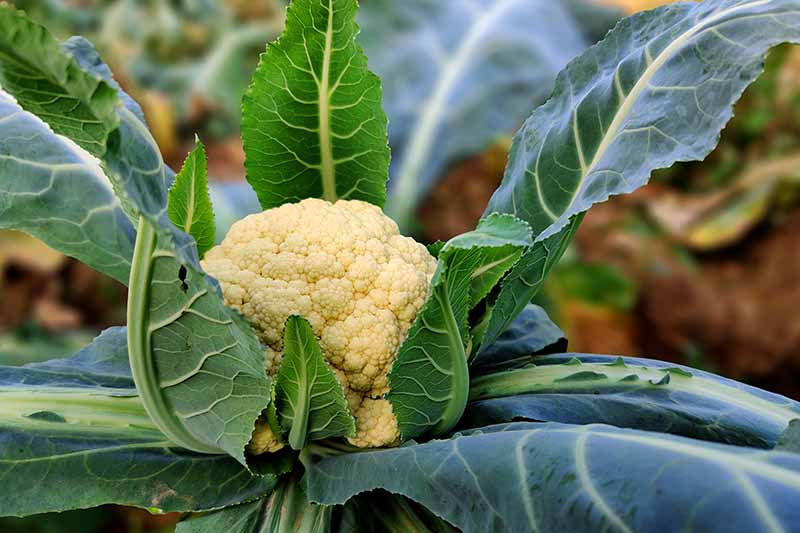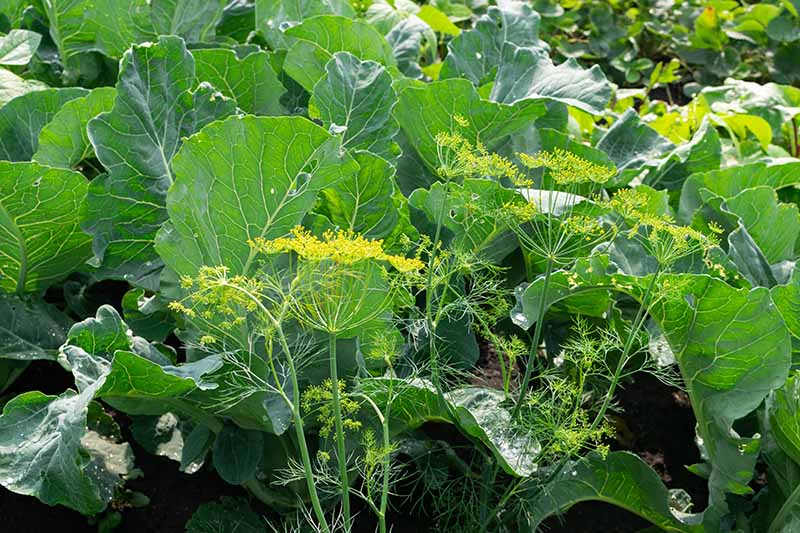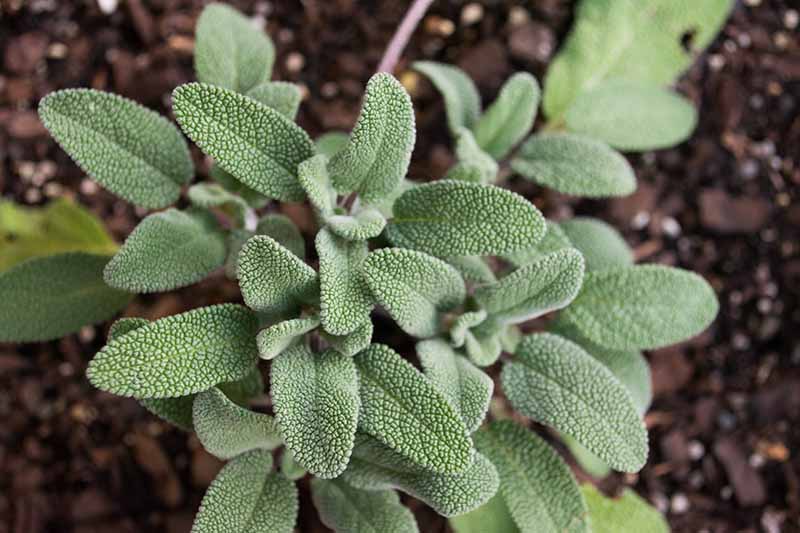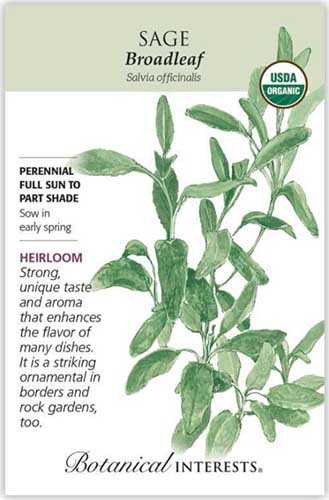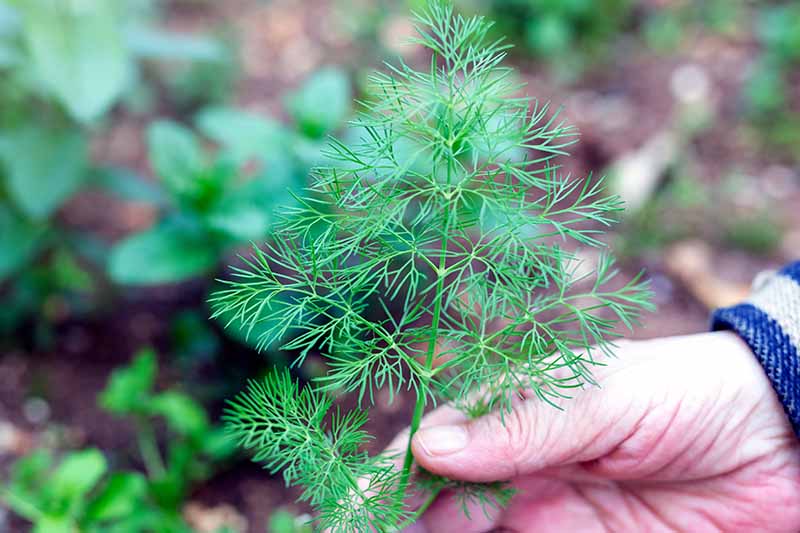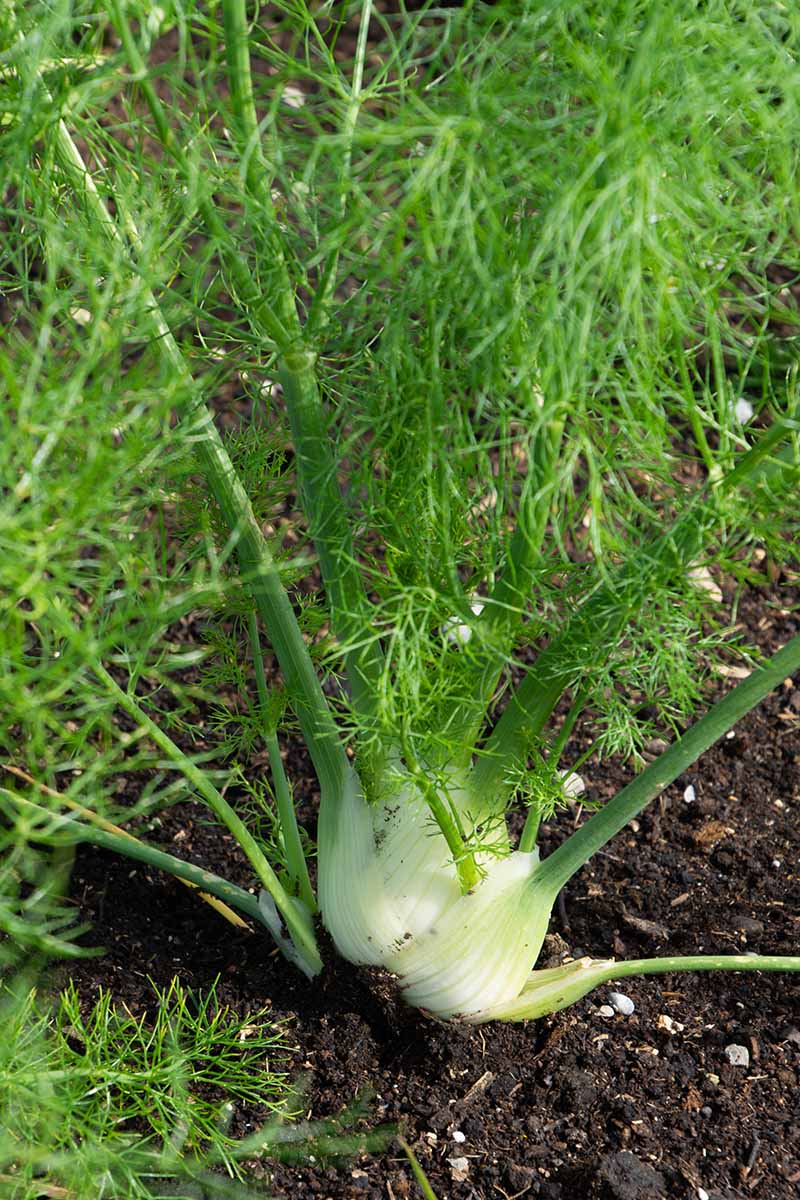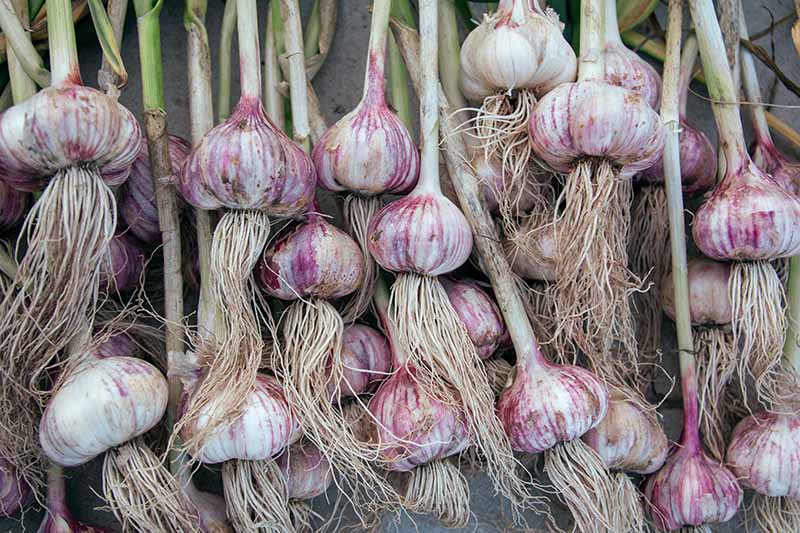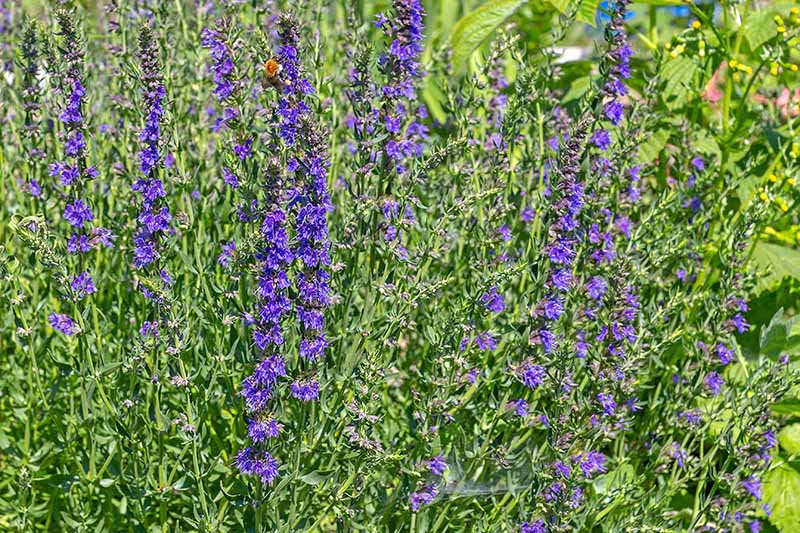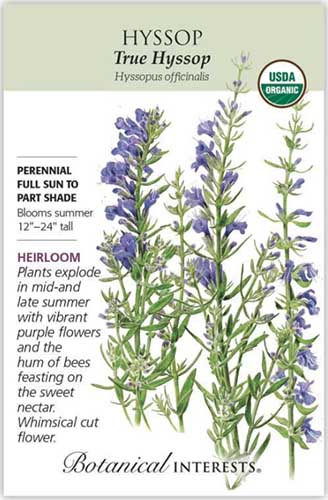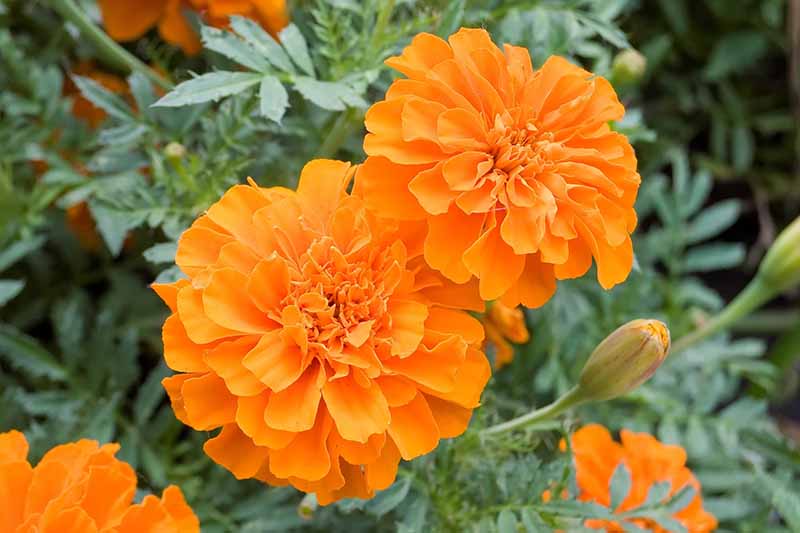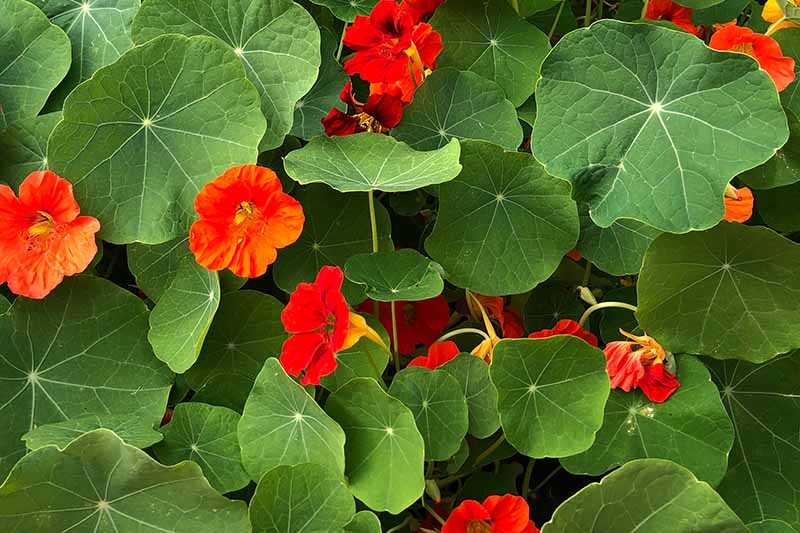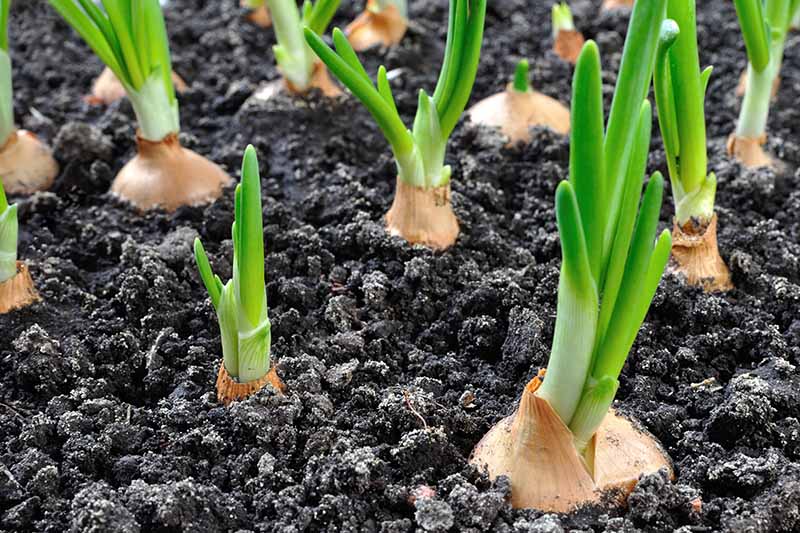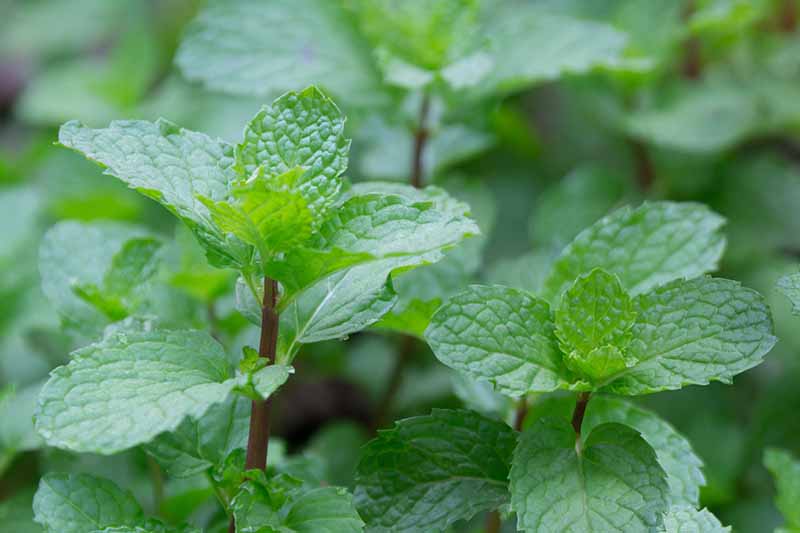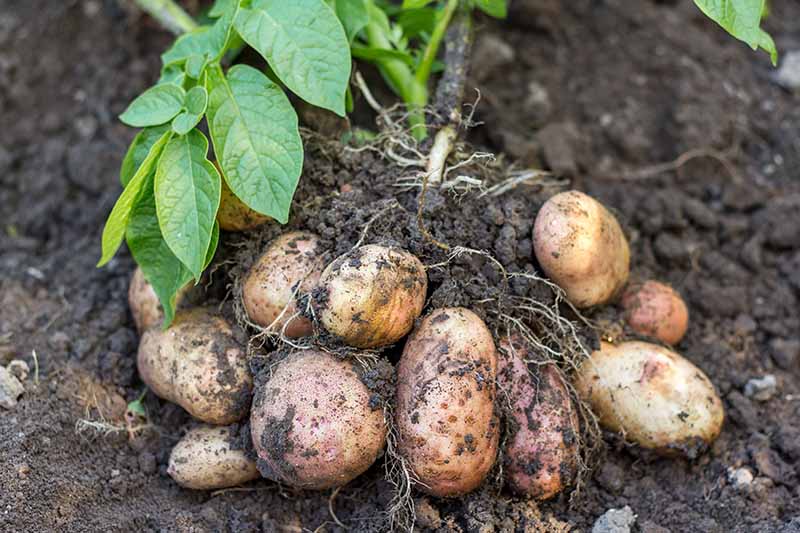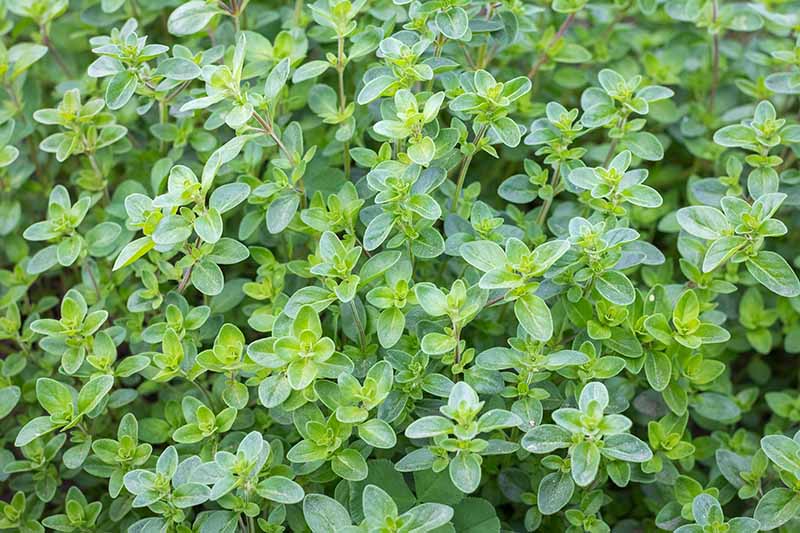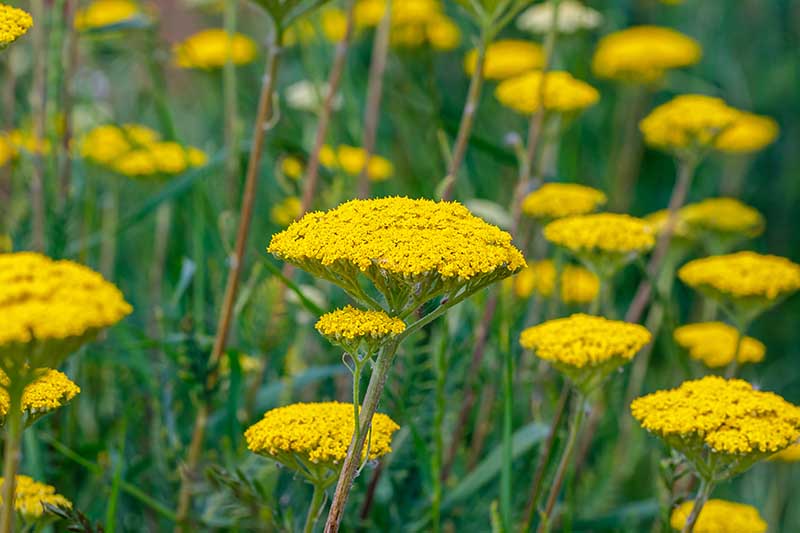Companion plants are those that share similar cultural requirements for sunlight, soil, and water, and that can live together in a non-competitive, harmonious environment. They may complement one another in a variety of ways, such as attracting beneficial insects, deterring insect pests, and promoting soil health. We link to vendors to help you find relevant products. If you buy from one of our links, we may earn a commission. A host of additional articles cover topics including common diseases, harvesting, and heading challenges. In this article, we present 13 types of plants that make excellent companions for cauliflower in the garden. Here’s the lineup: Let’s get started!
Considering Companions
The best plants to sow in proximity to cauliflower should share the same cultural requirements: even moisture, full sun, and organically-rich soil that drains well. Another point to consider is that cauliflower, like broccoli and other members of the brassica family, is a heavy feeder. If it has to tolerate competition for essential nutrients, especially nitrogen, it may not perform well. Other factors to think about are the pests associated with the plants you are considering for interplanting. Do they attract bugs that prey upon cauliflower pests? Or do they attract the same insects, making them excellent “trap crops” that lure pests to themselves instead of your heading crop? Ask yourself if these potential garden friends have useful growth habits, like sprawling to keep weeds at bay, or a tall stature to cast light afternoon shade in the warmest growing zones. Considerations like these should inform your co-planting choices. However, before you select suitable garden mates, you need to know that cauliflower is not the easiest plant to get along with. It contains compounds called allelochemicals that are released into the soil and are intolerable to many plants, potentially causing anomalies and even death. The soil may remain “contaminated” for quite some time after harvest, so keep this in mind when you rotate crops. Plants that do not tolerate these allelochemicals and that should not be planted with cauliflower and other brassica crops include:
CornCucumberPepperSquashStrawberryTomato
In some cases, larger transplants may be able to withstand the allelochemicals whereas seeds may fail to thrive. But in addition to their chemical intolerance, these plants are great consumers of water and nutrients, making them competitors instead of good companions. Cauliflower is unique in another way. Besides its unfriendly emissions, it is one of only five percent of the plant population that does not have a symbiotic relationship with beneficial mycorrhizal fungi. Myco who? Mycorrhizal fungi are soilborne organisms that are mutually beneficial to both fungi and the plants that have a symbiotic relationship with them. Here’s how it works: The plants provide carbohydrates for the fungi to eat, and the fungi absorb nutrients from the soil and transfer them to the plants. One such nutrient is nitrogen, which is essential for foliar development. Cauliflower, being a non-mycorrhizal plant, has no such relationship with a fungus that would help it to get nutrients from the soil. Some articles you may read about growing cauliflower with other plants raise the point that cauliflower companion plants that have a symbiotic relationship with mycorrhizal fungi may receive the preponderance of nutrients, leaving cauliflower deficient, especially in the nitrogen that’s essential for foliar development – the leaves that bring food to the heads we love to eat. They recommend growing this cruciferous vegetable alone. However, there’s more to the story. If you fertilize at planting time and during the growing season, and side dress at midseason, as recommended in our growing guide, you are not likely to find your plants are nutrient deficient. This is because the addition of fertilizer to the soil reduces the level of mycorrhizal activity, reducing the potential loss of nutrients to non-mycorrhizal plants like cauliflower. And the companions aren’t likely to suffer either. There are other stories, too. A wealth of plant folklore endows flora with properties both real and imagined. However, the experts of the West Virginia University Extension state, “The scents and bright colors of herbs and flowers confuse harmful pests and attract beneficial insects and pollinators.” A final note: avoid planting other brassicas with cauliflower, like brussels sprouts and cabbage, as they are all heavy feeders and will not only compete for water and nutrients, they attract the same pests as well. Companions don’t have to be superheroes, just harmless neighbors, and helpful ones if possible.
1. Culinary Sage
Broadleaf, common, or culinary sage, Salvia officinalis, is a perennial you may know from its role in the “parsley, sage, rosemary, and thyme” quartet of music and Thanksgiving fame. Its earthy fragrance deters pests, while its light blue blossoms attract beneficial pollinators, like the tiny parasitoid wasp and hoverfly, which prey upon caterpillars and aphids. You’re sure to like the robust sage you’ll harvest when you plant heirloom organic seeds. Culinary Sage In addition to the leaves, the flowers are also edible. Pinch some off for pretty salad garnishes. Not letting them run to seed is an effective way to prolong the growing season. You’ll find organic heirloom culinary sage seeds available at Botanical Interests in packages of 25. Sage will never compete with cauliflower for water, as it prefers conditions with dry to medium moisture. Learn to cultivate culinary sage with our growing guide.
2. Dill
If you grow annual dill, Anethum graveolens, and harvest it for its frothy masses of finely cut, aromatic leaves, you may have never seen it flower. For it to be a good companion, you’ll need to let at least a few plant “bolt,” or bloom, to attract beneficial insects to its umbels, or flattened flower heads packed full of tiny yellow flowers. They attract an array of pollinating bees and butterflies, as well as hoverflies, ladybugs, and lacewings that feed on aphids, as well as parasitoid wasps that lay their eggs in and destroy brassica caterpillars and aphids. ‘Dukat’ Dill The ‘Dukat’ cultivar is a slow-to-bolt variety with an above average-abundance of foliage and an exceptionally rich flavor. In addition to the leaves and the seeds, of dill pickle fame, the blossoms are also edible and make a lovely salad garnish. ‘Dukat’ dill seeds from the Mountain Valley Seed Company are available at True Leaf Market in one-gram, one-ounce, four-ounce, one-pound, and five-pound packages. Folk wisdom recommends not planting dill near fennel, as they may cross-pollinate with an adverse effect on flavor. However, take this with a grain of salt, as it is not scientifically proven. Like cauliflower, dill likes even moisture. See our dill growing guide to cultivate this herb at home.
3. Fennel
Aromatic sweet bulb fennel, Foeniculum vulgare, aka Florence fennel, is a short-lived perennial with an anise or licorice-like flavor that is delicious both raw and cooked. It is in the Apiaceae family, and is a relative of dill. All parts are edible, including the yellow umbel flower clusters that attract beneficial parasitoid wasps, ladybugs, butterflies, and bees. You can count on the ladybugs to feed on aphids, and the tiny non-stinging wasps to bring ruin to even more aphids, as well as brassica caterpillars. The pros at the Clemson University Extension Home and Garden Information Center advise, “Do not plant dill near fennel since they can cross and produce strangely flavored seedlings.” Florence Fennel In addition, fennel may cause growth anomalies in plants that are adversely affected by the allelochemicals it contains. Fennel has moderate water needs, and its roots go much deeper than those of cauliflower, so there are no competition worries here. You’ll find Florence fennel seeds available at Eden Brothers in one-ounce or quarter-pound packages. See our fennel growing guide to cultivate your own.
4. Garlic
Garlic, Allium sativum and A. sativum var. ophioscorodon, has a pungent aroma that is unappealing to pests. It is a perennial often grown as an annual. This bulb vegetable emits an antifungal sulfur compound into the soil that boosts soilborne fungi resistance not only to the garlic, but to surrounding plants as well. Garlic is an essential ingredient in dishes prepared around the world. Ready mid-season, ‘Metechi’ is a robust hard neck variety. Hard neck types grow scapes, or stalks, between a single row of cloves, unlike soft neck types that have no scape and produce multiple rows of cloves. ‘Metechi’ Garlic The scapes are as delicious as the garlic. Enjoy them as you would scallions or spring onions. You’ll find ‘Metechi’ Garlic bulbs available at Burpee in half-pound packages. Garlic is an especially light feeder with moderate water needs, making it cauliflower-friendly. See our guide to growing garlic for cultivation instructions.
5. Hyssop
There are two types of hyssop to consider. Both are perennials. There’s “true” hyssop, Hyssopus officinalis, and anise hyssop, Agastache foeniculum. Both are edible and attract beneficial pollinators like bees and butterflies to the garden. Also, both have low to medium moisture needs, so there won’t be any water competition. However, if you’re looking for a trap crop, you’ll want to choose true hyssop. It attracts pests that also feed on cauliflower, like brassica caterpillars, flea beetles, and slugs. True Hyssop Sow a perimeter of seeds around your crop, and brassica pests may be so busy munching the hyssop they don’t even know the vegetable is there. True hyssop seeds are available at Botanical Interests in 150-milligram packages. Enjoy the minty leaves and blossoms in refreshing summer salads. See our hyssop growing guide to learn more.
6. Marigold
The annual marigold (Tagetes spp.) is the subject of much lore, including the belief that it deters pests with its pungent smell. Actually, marigolds are valuable for the opposite reason: because they attract pests like aphids and soilborne nematodes that might otherwise munch on your veggies, making them an excellent trap crop. In addition, they draw pollinating bees that help enrich the biodiversity of a growing environment. One species that is believed to be especially beneficial is the French marigold, Tagetes patula. ‘Court Jester’ is an especially eye-catching T. patula cultivar, with its burgundy and yellow petals that resemble the pointy hat of a jolly jokester of the royal court, topped by a jaunty orange pompon. ‘Court Jester’ Marigold Marigolds are moderate consumers of water that won’t compete for moisture. You’ll find ‘Court Jester’ marigold seeds available at Eden Brothers in one-ounce or quarter-pound packages. Consult our marigold growing guide for all you need to know to cultivate this flower.
7. Nasturtium
Edible annual nasturtium (Tropaeolum spp.) makes a lovely garnish on cold summer plates. Its creeping growth habit cools the ground below as it keeps weeds at bay. The foliage appeals to aphids, flea beetles, and whiteflies, all pests that would otherwise zero in on your maturing vegetables. Use nasturtium generously as a trap crop. Its dry to moderate water needs guarantee it won’t hog the moisture from developing heads. ‘Alaska Gold Dwarf’ The golden blooms and variegated foliage of ‘Alaska Gold Dwarf’ make an impressive addition to the summer garden, attracting pollinators to benefit all. You’ll find ‘Alaska Gold Dwarf’ seeds available at True Leaf Market in packets containing three grams, or approximately 20 seeds. See our nasturtium growing guide to learn more.
8. Onion
The bulb onion, Allium cepa, is another odorous plant that deters pests from its vicinity, and many folks claim their other vegetables always taste better when planted near onions. Onions have low to medium water needs, and repel a range of pests like aphids, as well as caterpillars that feed specifically on brassicas. Also, as the onion is a particularly light feeder, so it doesn’t compete for nutrients. ‘Cippolini Red’ Onion The ‘Cippolini Red’ cultivar is a flattened reddish bulb with a bold yet sweet flavor like a shallot that’s wonderful in savory simmered dishes. You’ll find ‘Cippolini Red’ onion seeds available at Burpee in packages of 300 seeds. See our onion growing guide for cultivation information.
9. Oregano
Annual oregano, Origanum vulgare, is an herb you may know best as the pungent little green leaves that give your pizza its zing. Its moderate water needs and ability to withstand drought remove all concerns of moisture competition from this garden pal. A favorite of many a cook is Greek oregano, O. vulgare subsp. hirtum, a full-bodied variety many consider the best. Greek Oregano Pinch off leaves as needed before plants bloom for optimal flavor. But be sure to let some plants flower to attract beneficial insects, and to enjoy the pink, purple, or white blossom spikes as an edible garnish. Find Greek oregano seeds available at True Leaf Market in quarter-ounce, one-ounce, four-ounce, and one-pound packages. See our guide to growing oregano and learn to cultivate your own.
10. Peppermint
Perennial peppermint, Mentha x piperita, may be considered weedy and invasive by many, but if you love a fistful in your pitcher of home-brewed iced tea, you may welcome it. Mint spreads like crazy, and will consume garden real estate rapidly if you let it. In addition, it requires a good bit of water to keep it happy. So why is it a good companion? When brassica caterpillars, flea beetles, and nematodes prey upon it, they are not feeding on your crop. In addition, its fragrance does not appeal to aphids and cabbage moths. Peppermint The best way to invite peppermint to be a pal is to grow it in containers, although they do dry out quicker than ground soil and require vigilant watering. This way, mint won’t overtake the garden, won’t hog water, and can be beneficial. Let some flower to attract beneficial bees, hoverflies, and parasitoid wasps. You’ll find peppermint plants available at Burpee. Choose individual starter plants or starter plant bundles of three each. See our articles on growing peppermint and other types of mint to grow your own.
11. Potato
The potato, Solanum tuberosum, requires consistent moisture like cauliflower does, but once mature, some drought is tolerated. When grown beneath a generous layer of straw mulch, potatoes require less water. A thick layer of straw also inhibits weeds, reducing moisture competition even more. Aphids and flea beetles are attracted to potatoes, so interplanting them with cauliflower may result in less damage from these common brassica pests. Because of its long roots, planting potatoes with deep-rooted fennel and onions is not recommended, as they may compete for space and nutrients in the soil. ‘Rio Grande Russet’ Potatoes You’re sure to enjoy the fluffy goodness of a baked or mashed ‘Rio Grand Russet.’ You’ll find ‘Rio Grande Russet’ potatoes available at Burpee. Each package contains 10 tubers. Learn how to grow potatoes in our guide.
12. Thyme
Culinary or common thyme, Thymus vulgaris, is an annual herb with a spicy, earthy aroma that deters brassica caterpillars as well as cabbage butterflies and moths, and flea beetles as well. Thyme’s low water needs and drought tolerance make it a non-competitive pal. Let some of your plants bloom. The white or pinkish blossom spikes attract tiny beneficials like hoverflies and parasitoid wasps, and make a pretty summer garnish. Thyme You’ll find thyme seeds available at Eden Brothers in one-ounce, quarter-pound, and one-pound packages. To cultivate this herb, consult our guide to growing thyme.
13. Yarrow
Yarrow, Achillea millefolium, has an astringent aroma that some pests may find disconcerting, inhibiting their ability to find the brassicas they seek. However, it doesn’t offend pollinating butterflies. Its flower heads are umbels with many tiny blossoms that attract parasitoid wasps that prey upon soft-bodied caterpillars and aphids, as well as hoverflies, ladybugs, and lacewings that also feed on aphids. ‘Golden Yarrow’ ‘Golden Yarrow’ is not the “original” muted gold color you may remember, but a “canary” shade that’s almost neon in the sunshine. You’ll find ‘Golden Yarrow’ available at True Leaf Market in 250-milligram, quarter-ounce, one-ounce, or four-ounce packages. See our yarrow growing guide to learn more.
Valued Friends
When choosing plants, make selections that share the same cultural requirements, and aren’t likely to compete with each other for essential nutrients and water. Read seed packets to determine mature dimensions to avoid overcrowding. Take out your garden planner and use square-foot gardening guidelines to help you design a scheme with enough room for all of your chosen plants. Surround your cauliflower with its pals so they can run interference as trap crops against common cauliflower pests. Interplanting appropriate companions with cauliflower not only adds value to individual gardens, it benefits the green spaces of a community at large, attracting beneficial insects that contribute to botanical diversity, and helping to sustain fragile flora-fauna ecosystems. If you enjoyed this article, we recommend reading these cauliflower guides next:
How to Grow Cauliflower in Containers13 of the Best Cauliflower Varieties for the Home Veggie GardenWhen and How to Blanch Maturing Cauliflower Heads
